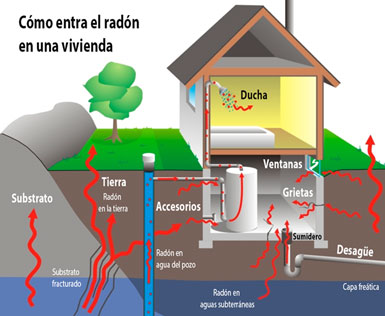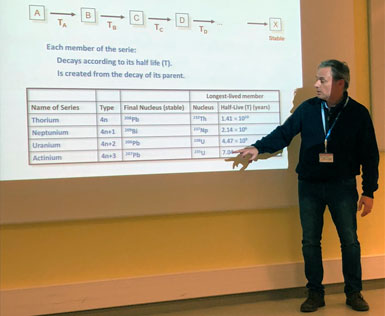24th January 2019 - Radon is a noble gas that is widely present in our environment. It is emitted by the subsoil, where it is originated from the decay of radium and uranium, and can penetrate the buildings without being noticed, since it is an odorless gas, without taste or color and soluble in water.
This unwanted guest is continually producing other radioactive elements that are present in the air that we breathe and that arrives to our lungs, depositing local energy and, if in high concentrations, damaging the lungs' tissue, what eventually can develop lung cancer. Nowadays radon is the second cause of lung cancer, after tobacco, being responsible for 9% of the deaths in Europe due to this disease.
The presence of radon varies considerably according to the season of the year, as well as to geographical area. For example, in Spain, areas such as Galicia, Extremadura or the Pyrenees have a higher concentration of radon in their soils. The Spanish Nuclear Safety Council (CSN) has published a map with the distribution of radon in Spain.
In 2018 a European Directive was published to regulate the maximum levels of radon (2013/59 / EURATOM), establishing that the maximum annual concentration of radon should not exceed 300 becquerels (Bq) per cubic meter.
The ALBA Synchrotron and the Universitat Autònoma de Barcelona (UAB) have carried out a study in which they have measured the levels of radon during a year in 20 areas of the scientific facility (ground, underground or semi-basement floors). The measurement campaigns were performed in four consecutive periods, taking into account the seasonal changes, using passive detectors that allow obtaining the average value of the radon concentration in periods of several months.
The results conclude that none of the analyzed areas reaches the annual average value of 300 Bq / m3. In a single place of an underground room, where the permanence of people is very limited, there is an annual value of 179 ± 72 Bq / m3. In spite of the fact that it does not exceed the maximum allowed concentration, a second study is planned to analyse in more detail this limited area and to take appropriate measures. In the rest of the whole ALBA premises the average is 40 ± 11 Bq / m3 and therefore radon does not represent an additional risk for workers and users of the ALBA Synchrotron.
This study has been contracted by the Radiation Protection Service of ALBA, which is in charge of controlling and optimizing the radiation levels of the ALBA accelerators.


On the left, graph showing how radon enters a home. Source: Foro Nuclear. On the right, researcher Lluís Font Guiteras from the UAB, presenting the results of the study in the ALBA Synchrotron last 19th December 2018.




